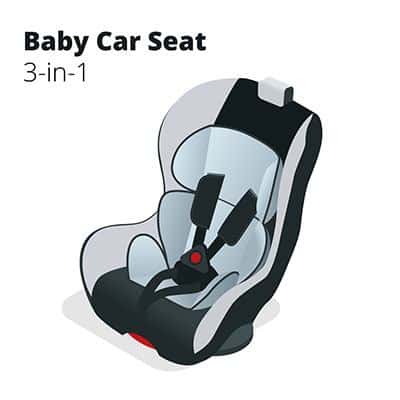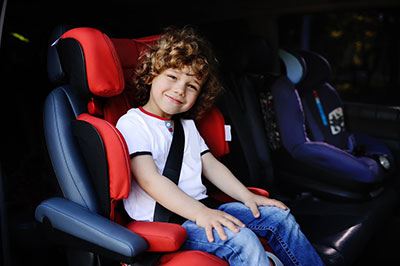All-in-one car seats are becoming increasingly popular as a safe and convenient way to travel with your child.
These car seats offer unparalleled convenience and safety, as they have been rigorously safety tested to ensure they meet the latest safety standards. In addition, with an all-in-one car seat, parents can easily transition their children from rear face to face forward and then to a booster seat and high-back booster mode without purchasing multiple pieces of equipment.
Not only are all-in-one car seats easier on your pocketbook, but they also provide peace of mind that you're keeping your child as secure as possible.
More...
Take Away Key Point:
What is an all-in-one car seat?
An all-in-one car convertible seat is a child safety seat that can transform as your child grows. It usually begins as rear-facing, then turns into a forward-facing car seat, and finally converts into a high-back booster mode seat when your child is ready.
All-in-one car seats are designed to keep children safe and secure at every stage of growth while providing parents with the convenience of having just one piece of equipment.

All-in-one car seats come with three stages of use:
- Rear-facing: The rear-facing child's car seat can be used first as an infant car seat. This is designed for infants and young toddlers up to 40 lbs or until their first birthday, whichever comes first. They should remain in the rear-facing position as long as possible, as it provides the most protection from any crash forces.
- Forward-facing: Once your child is 40 lbs and older (or one year old), you can switch to the forward-facing mode, which allows them to face the front of the vehicle. This stage typically supports kids up to 65 lbs or 4 years old, depending on which specific model you have purchased.
- Booster seat: When they reach 65 lbs and 4 years old, the final stage will be a booster seat so they can sit safely with just the standard adult lap and shoulder belt and no extra harnesses. This mode can last until they are at least 8 years old or 80 lbs, depending on their height and weight limit and your local laws regarding booster seat usage. With proper installation, many parents enjoy using the big kid seat as a high-back or backless booster as their last car seat option!
Types of all-in-one car seats
1. 3-in-1 car seat
3-in-1 child car seats are designed to grow with your child, offering different stages of use that accommodate different age and size ranges.
A single car seat in its first stage is a rear-facing position, which offers the greatest protection as an infant car seat and toddlers up to around age two. The rear-faced convertible car seats usually have a car seat base. The car seat base is reserved for infant car seat mode, while its weight limits must be strictly followed! Along with the car seat base, the single car seat should be used with infant inserts.
From there, they transition to a forward-facing five-point harness system until they reach 40 pounds or 18 kilos. When they outgrow this stage, you can transition them to a booster seat that uses the lap and shoulder belt for extra security until they have reached the height requirement of 4 feet 9 inches tall.
At this point, many families can use regular seatbelts without any extra support.
2. 4-in-1 convertible car seat
4-in-1 child car seats offer four stages of use that accommodate different age and size ranges.
The first stage is a rear-facing position, which can be used as an infant car seat and a rear-facing seat for young toddlers. Make sure to use the rear-facing belt path with this position. The child should stay rear-facing until they reach the weight limit or height for their first car seat in a forward-facing position.
From there, they transition to a forward-facing five-point harness system until they reach 40 pounds or 18 kilos.
After that, you can use the booster seat with the lap and shoulder belt for extra security until they are ready for regular seatbelts without extra support.
Finally, when your child has outgrown the seat altogether, you can remove all the components and use it as a backless booster for even older children.
3. 5-in-1 car seat
5-in-1 child car seats provide five stages of use that accommodate different age and size ranges.
The first stage is a rear-facing position, which offers the greatest protection for infants and toddlers up to around age two. Just like with the previous two all-in-one seats, this rear-facing position should be used with a base during the infant seat mode, along with the rear-facing belt path.
From there, they transition to a forward-facing five-point harness system until they reach 40 pounds or 18 kilos.
After that, you can use the booster seat with the lap and shoulder belt for extra security until they are ready for regular seatbelts without any additional support. Then, when your child has outgrown the seat altogether, you can remove all the components and use it as an adjustable backless booster for even older children.
Finally, when your child has reached 57 inches tall, you can convert it into a traditional belt-positioning booster seat with an adjustable headrest to keep them safe and comfortable on longer rides.
4. Advantages of all-in-one car seats

All-in-one car seats offer several advantages over traditional car seats.
The main advantage is that they can accommodate all stages of a child's growth and development from infancy to early adulthood—they start as rear-facing infant seats, then become forward-facing harnesses, then high-back booster seats, and finally backless boosters for larger children.
This means you won't need to buy multiple different kinds of car seats as your child grows and develops. Additionally, all-in-one car seats often provide better safety features than separate models can, such as deeper headrests and side impact protection.
Finally, many all-in-one models have adjustable heights and positions that make long trips more comfortable for parents and children.
5. Disadvantages of all-in-one car seats
All-in-one car seats also have several disadvantages.
The main disadvantage is that they're often bulkier and heavier than traditional car seats, making them difficult to move from one vehicle to another.
Additionally, the safety features of all-in-one car seats may not be as comprehensive as separate models—they may not provide three or more points of protection, for example.
Finally, some parents find using all the different components and adjustments in an all-in-one model challenging, so it can be more time-consuming and demanding than buying a regular car seat.
6. What level of support do all-in-one car seats provide?
All-in-one car seats provide your child with the highest safety and security.
These car seats offer up to five stages, from infant carrier to booster seat. In addition, all-in-one seat models feature adjustable straps and harnesses, padding to support the head and neck, and side impact protection.
Some all-in-one car seats even include adjustable recline positions for added comfort and support.
7. Infants & all-in-one seats: is it safe?
Yes, it is safe to use an all-in-one car seat with infants. All-in-one car seats offer a five-point harness system, adjustable headrests, superior impact resistance, and side impact protection.
Plus, they come with additional padding for comfort and support. When used correctly and according to the manufacturer's instructions, they can provide your child with a safe and comfortable ride from infancy through booster seat age.
Infant car seats are designed to provide the most support for newborns, with an adjustable base, straps, and buckles and a 5-point harness system for added comfort.
3-in-1 car seats accommodate children up to 65 lbs, while 4-in-1 car seats are suitable for children up to 100 lbs or more, with extra features such as extended backrests and multiple reclining positions.
All-in-one car seats offer superior safety features like side impact protection and adjustable headrests. In addition, they are tested to meet all applicable safety regulations, so you can rest assured that your child is in safe hands!
Car seat safety regulations
Car seat safety regulations vary by country and jurisdiction, but in general; these are the main ones:
- Always read and follow the manufacturer's instructions.
- Ensure that harness straps are in the correct position and tightened correctly.
- Make sure that the car seat is compatible with your vehicle before installation.
- Never use a car seat if it has been involved in an accident or has any signs of wear or damage.
Instead, use a tether when appropriate to secure a forward-facing car seat to your vehicle's anchor points.
- Do not modify or alter the car seat in any way, including removing parts or adding padding or other materials not explicitly approved by the manufacturer.
- Make sure all passengers have proper use and fit of their respective seats at all times while traveling in the vehicle, regardless of age and size.
How do I check if an all-in-one car seat is compatible with my vehicle?
You can take a few steps to determine if an all-in-one car seat is compatible with your vehicle.
- Look for labels on the car seat: You should look for labels or markings that confirm the car seat is certified for use in your vehicle. Please refer to the manufacturer's instructions for further details.
- Consult your vehicle's owner manual: Your vehicle's owner manual will contain information about the specific make and model of the car you are driving and the types of car seats that can be used in it.
- Test fit: Before installing any convertible car seat, it is important to test fit first. Review the installation instructions provided by the manufacturer and check if any special requirements or modifications are required for installation in your vehicle.
- Contact a Certified Child Passenger Safety Technician (CPST): If you have any questions or concerns, a Certified Child Passenger Safety Technician can guide and assist with finding a safe and compatible car seat for your child and your vehicle.
FAQs
What is the difference between 4-in-1 and 3-in-1 car seats?

The main difference between 4-in-1 and 3-in-1 car seats is the number of usage stages available. A 4-in-1 seat typically offers four stages: infant, toddler, harness, and booster. On the other hand, aA 3-in-1 traditionally only has three stages: infant, toddler (with a 5-point harness), and booster.
Additionally, 4-in-1 models often offer more adjustable features than 3-in-1 models to help ensure a snug fit.
Can you put a newborn in a 3-in-1 car seat?
You can put a newborn in a 3-in-1 car seat, but using an infant carrier for the first year of your baby's life is highly recommended. This is because 3-in-1 car seats do not typically offer any extra head, neck, and body support that an infant carrier would provide.
Furthermore, larger babies may outgrow the 5-point harness on a 3-in-1 before their first birthday.
Final Words
All-in-one car seats offer the highest level of support and safety, with five stages of usage in one seat: newborn, toddler (with 5-point harness), high back belt-positioning booster, backless booster seat, and vehicular seat belt guide.
Additional features include adjustable headrests, body padding for extra support, and side impact protection, and they often come with additional headrest and body padding for extra support.
